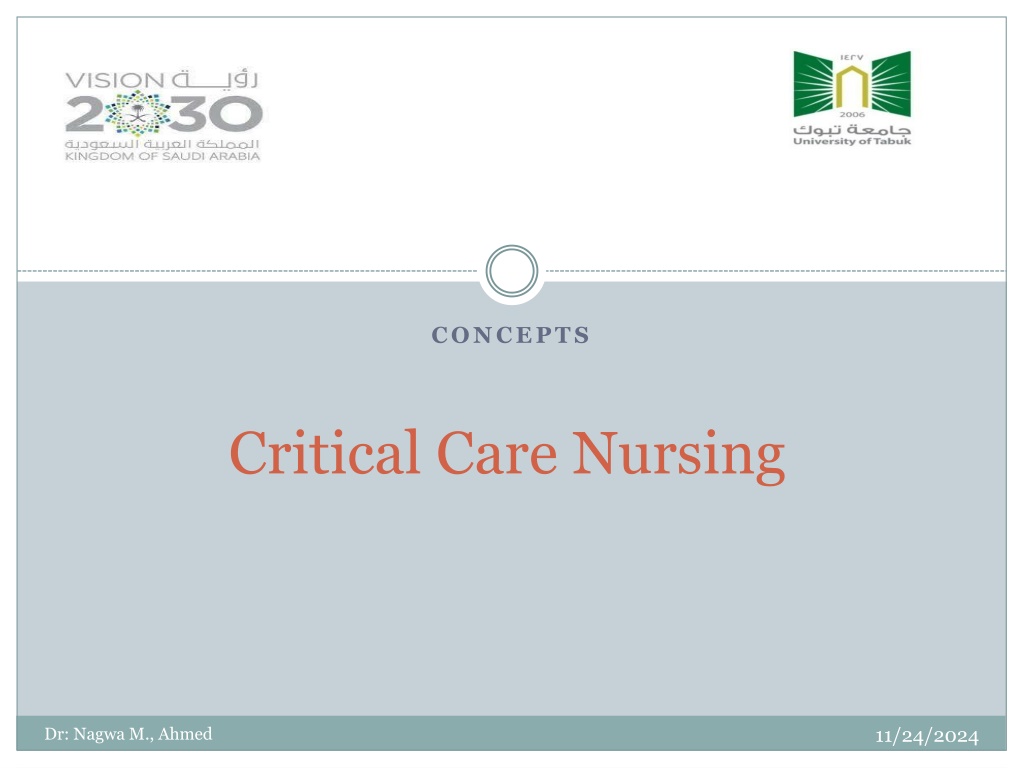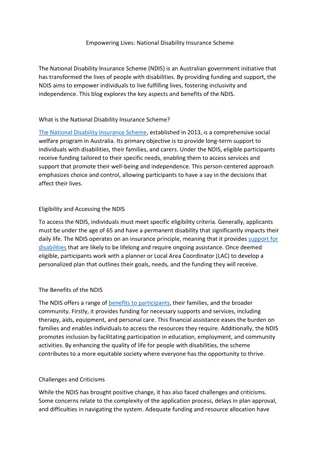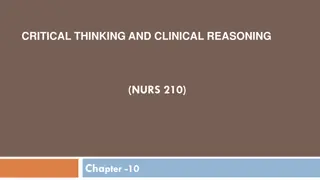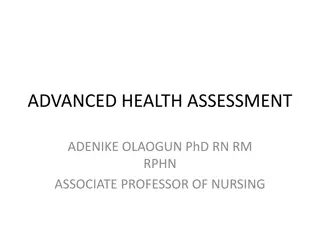Understanding Critical Care Nursing: Principles, Definitions, and Types of Units
Critical care nursing involves providing specialized and individualized care to patients with life-threatening conditions. The concept, principles, definitions, and types of critical care units are discussed, emphasizing the importance of early detection, prompt action, and anticipating patient needs. Various critical conditions and types of critical care units are highlighted by Dr. Nagwa M. Ahmed.
Download Presentation

Please find below an Image/Link to download the presentation.
The content on the website is provided AS IS for your information and personal use only. It may not be sold, licensed, or shared on other websites without obtaining consent from the author. Download presentation by click this link. If you encounter any issues during the download, it is possible that the publisher has removed the file from their server.
E N D
Presentation Transcript
CONCEPTS Critical Care Nursing 11/24/2024 Dr: Nagwa M., Ahmed
Overview of Critical Care Nursing Concept Concept of critical care Principles of Critical Care Nursing Common Nursing Care With rationale 11/24/2024 Dr: Nagwa M., Ahmed
DEFINITIONS DEFINITIONS CRITICAL CARE : Critical care is a term used to describe as the care of patients who are extremely ill and whose clinical condition is unstable or potentially unstable. CRITICAL CARE UNIT : It is defined as the unit in which comprehensive care of a critically ill patient which is deemed to recoverable stage is carried out. CRITICAL CARE NURSING : It refers to those comprehensive, specialized and individualized nursing care services which are rendered to patients with life threatening conditions and their families. 11/24/2024 Dr: Nagwa M., Ahmed
What are the conditions considered as Critical? ANY PERSON WITH LIFE THREATENING CONDITION PATIENTS WITH : Acute Renal Failure Acute Myocardial Infraction CARDIAC TAMPONATE Severe Shock Heart Block Acute Renal Failure Poly Trauma, Multiple Organ Failure And Organ Dysfunction Severe Burns 11/24/2024 Dr: Nagwa M., Ahmed
TYPES OF CRITICAL CARE UNIT: TYPES OF CRITICAL CARE UNIT NEONATAL INTENSIVE UNIT (NICU) SPECIAL CARE NURSERY (SCN) PAEDIATRIC INTENSIVE CARE UNIT (PICU) PSYCHIATRIC INTENSIVE UNIT (PICU) CORONARY CARE UNIT (CCU) CARDIAC SURGERY INTENSIVE CARE UNIT (CSICU) CARDIOVASCULAR INTENSIVE CARE UNIT (CVICU) MEDICAL INTENSIVE CARE UNIT (MICU) MEDICAL SURGICAL INTENSIVE CARE UNIT (MSICU) SURGICAL INTENSIVE CARE UNIT (SICU) TRAUMA INTENSIVE CARE UNIT (TICU) SHOCK TRAUMA INTENSIVE CARE UNIT (STICU) TRAUMA NEURO CRITICAL CARE INTENSIVE CARE UNIT (TNCC) RESPIRATORY INTENSIVE CARE UNIT (RICU) GERIATRIC INTENSIVE CARE UNIT (GICU) 11/24/2024 Dr: Nagwa M., Ahmed
PRINCIPLES OF CRITICAL CARE NURSING ANTICIPATION : One has to recognize the high risk patients and anticipate the requirements, complications and be prepared to meet any emergency. EARLY DETECTION AND PROMPT ACTION : The prognosis of the patient depends on the early detection of variation, prompt and appropriate action to prevent or combat complication. 11/24/2024 Dr: Nagwa M., Ahmed
COMMUNICATION : Intra professional, inter departmental and inter personal communication has a significant importance in the smooth running of unit. Prevention of Infection : Nosocomial infection cost a lot in the health care services. Critically ill patients requiring intensive care are at a greater risk than other patients due to the immunocompromised state with the antibiotic usage and stress, invasive lines, mechanical ventilators, prolonged stay and severity of illness and environment of the critical unit itself. 11/24/2024 Dr: Nagwa M., Ahmed
ORGANIZATION OF ICU DESIGN OF ICU Should be at a geographically distinct area within the hospital, with controlled access. There should be a single entry and exit. However, it is required to have emergency exit points in case of emergency and disaster. There should not be any through traffic of goods or hospital staff. Supply and professional traffic should be separated from public/visitor traffic. 11/24/2024 Dr: Nagwa M., Ahmed
Safe, easy, fast transport of a critically sick pt should be a priority in planning its location. Therefore, the ICU should be located in close proximity or ER, OT, trauma ward etc. Corridors, lifts and ramps should be spacious enough to provide easy movement of bed/trolley of a critically sick patient. Close, easy proximity is also desirable to diagnostic facilities, blood bank, pharmacy etc. BED STRENGTH: It is recommended that total bed strength in ICU should be between 8-12 and not less than 6 or not more than 24 in any case. 11/24/2024 Dr: Nagwa M., Ahmed
Common Nursing Role in Critical Care Unit 11/24/2024 Dr: Nagwa M., Ahmed
Attendance No critical care patient will be left without a nurse in attendance. Rationale: Critically ill patients may have life- threatening changes in their condition; remove an invasive line or self-extubate quickly. 11/24/2024 Dr: Nagwa M., Ahmed
Entire care Each nurse will be responsible for the entire care of his/her patient, and acts to coordinate care with other health team professionals. Rationale: The caregiver, by assuming full responsibility for monitoring the patient's condition and care, can detect changes promptly. 11/24/2024 Dr: Nagwa M., Ahmed
Monitoring Alarms must be left on the ECG and arterial lines at all times. Rationale: To ensure rapid detection of heart rate or BP changes. 11/24/2024 Dr: Nagwa M., Ahmed
Temperature Temperatures will be measured on all patients at least q4h by other than axilla route. Patients having abnormal temperatures (< 36 or >37.5 C) (rectally, tympanic, pulmonary artery, esophageal, foley). Rationale: Temperature changes may indicate infection or other disease states. Core represents a much more accurate value. 11/24/2024 Dr: Nagwa M., Ahmed
Neurological Problems All patients admitted for neurological problems will have hourly neurological assessments performed. Rationale: To identify the deterioration 11/24/2024 Dr: Nagwa M., Ahmed
Position Changes The turning of all critically ill patients every two hours around the clock is done unless contraindicated. Rationale: This is to relieve pressure points and allow for skin perfusion as well as provide reference for comparison of skin care. 11/24/2024 Dr: Nagwa M., Ahmed
Chest Physio All intensive care patients will have chest PT q4h and PRN unless contraindicated. Rationale: Immobility increases the risk for the retention of secretions and reduced ventilation. 11/24/2024 Dr: Nagwa M., Ahmed
Range of Motion Exercise All critical care patients will have range of motion exercises q4h unless contraindicated. Rationale: To reduce possible contracture formation 11/24/2024 Dr: Nagwa M., Ahmed
Mouth care All Critical Care patients will have mouth care done every four hours with inspection for oral skin sores. Rationale: Intubation increases risk for developing mouth ulcers and/or infections. 11/24/2024 Dr: Nagwa M., Ahmed
Infection Protocol Isolation technique will be followed as per infection control manual. Rationale: To minimize cross infection to patients, visitors, and staff. 11/24/2024 Dr: Nagwa M., Ahmed























